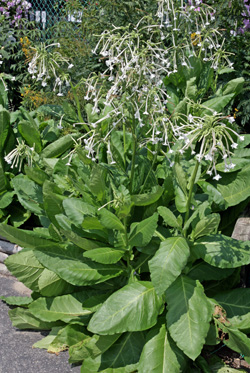
Tobacco (Nicotiana spp.) is a large group of plants in the nightshade family (Solanaceae). A few species are quite attractive and have been used as garden ornamentals for a long time. N. sylvestris is one such species with large, dramatic leaves and showy, fragrant clusters of pendent white flowers that look like a burst of fireworks. Native to northwestern Argentina, this short lived tender perennial is only hardy to zone 10 (although it may survive further north if protected) and grows so rapidly that it is generally used as an annual.
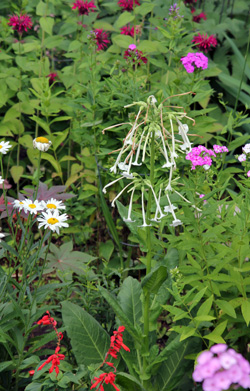
In Victorian gardens, it was planted along walkways and paths in so that those strolling by could enjoy the fragrance of the flowers and in modern times it was given the Royal Horticultural Society’s Award of Garden Merit. It is also one of the parents of commercial tobacco that is a hybrid of two or three species and only exists in cultivation. Some common names for this herbaceous species include flowering tobacco, night scented tobacco, South American tobacco, and woodland tobacco. The most common cultivar is ‘Only the Lonely’, whose name supposedly refers to it being so tall that it stands out from everything else.
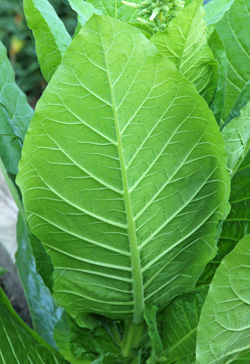
N. sylvestris grows quickly from seed, attaining a height of 3-5 feet and spreading up to 2 feet across at the base. Wide, oblong leaves to 18” long are produced in a dense basal rosette. In partial shade, the leaves are much larger and a deeper green than on plants grown in full sun, which may look almost chartreuse. The rough-textured leaves are covered with glandular hairs that make them feel sticky and may cause dermatitis in sensitive individuals. The bright green leaves have clasping or winged petioles, that surround the stem – these are most noticeable on the upper leaves.
In midsummer the plant produces a central flower spike that grows rapidly several feet tall. The leaves along the erect stem decrease in size up the stem. The stems and root systems are strong enough that the plants can lean at severe angles without toppling over or requiring staking, although branches can break at the base in strong storms or under very windy conditions.
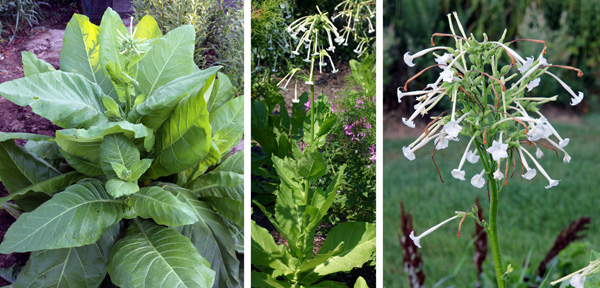
Pendant clusters of pure white to cream, tubular flowers are produced any time from June until the first frost. The main stem may be many-branched, producing multiple loose clusters of flowers. The flowers emit a strong, sweet, jasmine-like scent especially in the evening to attract their sphinx moth pollinators (although they probably are not required as plants exhibit high levels of self-pollination). Each flower has a long tube with a flared, star-shaped end. The flower clusters can be cut to use in fresh flower arrangements.

Copious amounts of tiny seed are produced from each pollinated flower, held in a rounded capsule surrounded by the persistent calyx. The very small brown seeds are ovoid to kidney shaped. This species self-seeds readily but the seedlings are easy to identify and pull if unwanted, so volunteers are not a big problem in gardens in cold climates. This can be problematic in other areas where it can naturalize in open, disturbed areas.
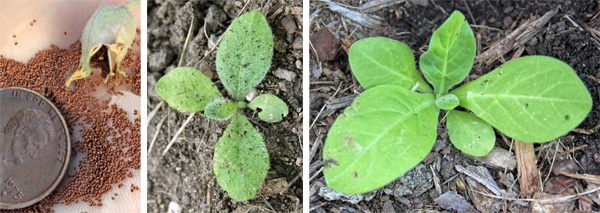

Use flowering tobacco in masses at the back of the annual or mixed border as a stunning backdrop for smaller plants, as a tall accent plant, or in a large mixed container. Its bold architectural presence complements almost any garden style from tropical to traditional. It is right at home in the cottage garden and is a natural for a moon garden. Position the plants where their delightful fragrance can be appreciated in the evening.
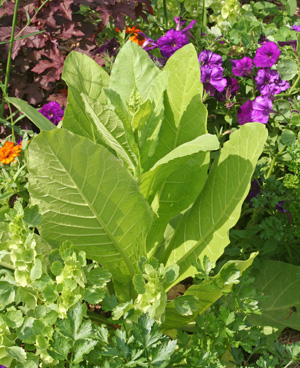
Combine them with other tall, late-summer bloomers such as cleome, cosmos (Cosmos bipinnatus), Verbena bonariensis, late-blooming shrub roses, and ornamental grasses, or use them to fill in gaps left by spring bulbs or spring blooming perennials that go dormant later on, such as Oriental poppy (Papaver orientalis). Their large leaves provide coarse texture that contrasts well with other plants with small leaves or fine texture.
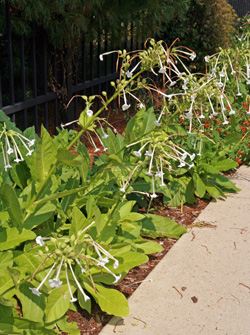
N. sylvestris grows best in full sun but will tolerate partial shade. It thrives in all types of soils with moderate moisture requirements but prefers rich soils, so amend planting sites generously with compost if possible. It is easily grown from seed, either sown indoors 6-8 weeks before the last average frost or sown directly in the garden after the last frost.
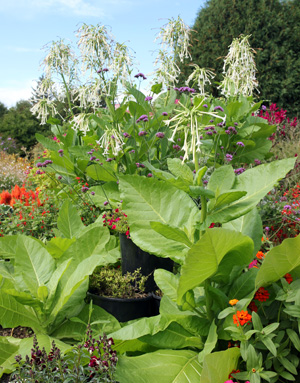
Surface sow the seeds and barely cover, as they need light to germinate. At least 12 hours of light per day is necessary for the seeds to germinate. Germination should occur in 1½-3 weeks. Seedlings should be transplanted into the garden after the last frost. The tiny seedlings can quickly fill a 3-4 square foot area, so give them room.
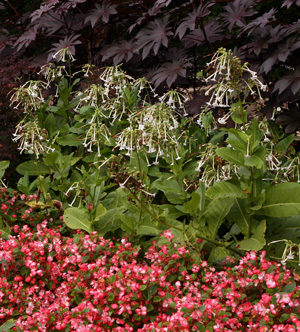
The tips of the first flower spikes can be pinched out to promote branching and more flower clusters. Deadhead spent flower clusters to encourage more blooms and reduce self-seeding. When growing in windy areas or unsupported by other plants, these tall plants may need staking. If the soil is not particularly rich, fertilize heavily to support their substantial growth. Tobacco has some pests, including aphids and tobacco hornworm, as well as a few diseases but these generally are not serious.
– Susan Mahr, University of Wisconsin – Madison
Ask Your Gardening Question
If you’re unable to find the information you need, please submit your gardening question here:





 Marigolds
Marigolds Create a Butterfly Garden
Create a Butterfly Garden Plant Flowers to Encourage Beneficial Insects
Plant Flowers to Encourage Beneficial Insects Forcing Bulbs
Forcing Bulbs


